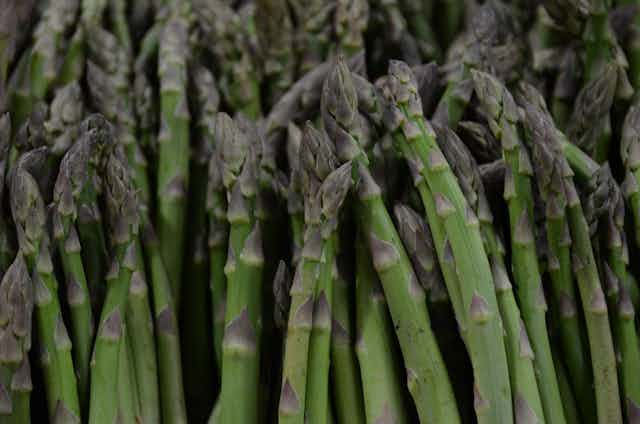Australia has some of the world’s most ancient soils, many of which grow delicious produce. In this series, “The good earth”, soil scientist Robert Edis profiles some of those soils and the flavours they bring.
The soil that grows the best asparagus in the world is the peaty Black Vertosol, in the Koo-Wee-Rup district 60km south-east of Melbourne. The most famous of these soils is the Dalmore clay – peaty phase. Many places renowned for their geo-culinary perfection are a happy mix of climate and soil factors. But in this case, it’s all about the soil.

Vertosols are those big black clayey soils - in this case more than 60% clay - that swell when wet and shrink and crack when drying out (they’re also known as reactive clays: one example is smectite).
The clays have a very high negative charge at their surfaces, where huge amounts of nutrients are held. When plant roots absorb nutrients from the water in the soil pores these nutrients are slowly released. Of all soil types, Vertosols have the highest capacity to store nutrients this way.

Soils with high clay contents can become waterlogged, and then when dry they can set very hard. But this area of Koo-Wee-Rup was once known as the “Great Swamp”, and here the presence of the peat - left over from the swamp days - makes this soil well drained internally. When dry it remains soft and crumbly and plant roots can explore all the resources the soil has to offer. This soil is also self-mulching, a rare phenomenon that leads to the surface becoming loose and granular just through wetting and drying cycles.
All plants grow well in this soil and are full of flavour and nutrition. But with asparagus, very special magical things happen as the spear of the asparagus pushes through the soil to emerge at the surface for harvest. The absence of sand grains, the slipperiness of the fine clay particles (less than a thousandth of mm across) and the soft buoyancy from the peat and self-mulching mean the asparagus spear slides through the soil like a wet tongue through fairy floss. The resulting spear has the softest skin and most flavour of any, and is most prized by asparagus connoisseurs throughout the world.
This is a very young soil, the product of the richest part of a swamp system some 40,000 ha in area that was drained in the early 1900s. It won’t last forever though. The peat is slowly oxidising, and as it is lost the soil will become more prone to waterlogging and hardsetting, becoming suitable only for grazing or housing (or reverting to wetland). Get into it while you can!


